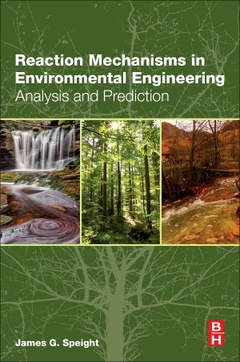Description
Reaction Mechanisms in Environmental Engineering
Analysis and Prediction
Author: Speight James G.
Language: English
Subject for Reaction Mechanisms in Environmental Engineering:
Keywords
3.0 types of chemicals; Absorption; Acid-base chemistry; Acids; Adsorption; Advantages and disadvantages; Advection; Aerobic biodegradation; Air pollution; Anaerobic biodegradation; Bases; Bimetallic chemicals; Bioaugmentation; Bioavailability; Biodegradation; Bioremediation; Biostimulation; Biotransformation; Boiler slag; Bottom ash; Catalytic transformation; Chemical transformation; Chemical transformations; Chemistry in the environment; Complexation; Concentration; Desorption; Diffusion; Dilution; Dispersion; Dissolution; Distribution in the environment; Dithionate; Emulsification; Environment; Evaporation; Fenton reagent; First law of thermodynamics; Fly ash; Free energy; Household chemicals; Hydrolysis reactions; Hydrolysis; In situ and ex situ methods; Industrial chemicals; Ion exchange; Iron minerals; Land pollution; Leaching; Minerals; Molecular interactions; Nucleophilic substitution reaction; Oxidation; Ozone; Partition coefficients; Partitioning; Permanganate; Persulfate; Photocatalysis; Photochemistry; Photolysis; Polysulfides; Radioactive decay; Rate of dissolution; Rearrangement; Redox reactions; Reduction reactions; Release into the environment; Second law of thermodynamics; Sedimentation; Solubility of inorganic chemicals; Solubility of organic chemicals; Solubility; Sorption; Sources; Spreading; Sublimation; The aquasphere; The atmosphere; The lithosphere; Thermodynamics; Transport of pollutants; Vapor pressure; Volatility; Water pollution; Water solubility; Zero valent metals
456 p. · 15x22.8 cm · Paperback
Description
/li>Contents
/li>Readership
/li>Biography
/li>Comment
/li>
Reaction Mechanisms in Environmental Engineering: Analysis and Prediction describes the principles that govern chemical reactivity and demonstrates how these principles are used to yield more accurate predictions. The book will help users increase accuracy in analyzing and predicting the speed of pollutant conversion in engineered systems, such as water and wastewater treatment plants, or in natural systems, such as lakes and aquifers receiving industrial pollution. Using examples from air, water and soil, the book begins with a clear exposition of the properties of environmental and inorganic organic chemicals that is followed by partitioning and sorption processes and sorption and transformation processes.
Kinetic principles are used to calculate or estimate the pollutants' half-lives, while physical-chemical properties of organic pollutants are used to estimate transformation mechanisms and rates. The book emphasizes how to develop an understanding of how physico-chemical and structural properties relate to transformations of organic pollutants.
Part 1: Introduction1. Introduction2. Environmental Organic Chemicals
Part 2: Partitioning and Sorption Processes3. Molecular Interactions, Partitioning, and Thermodynamics4. Vapor Pressure5. Aqueous Solubility and Activity Coefficients6. Air Water and Air Organic Solvent Partitioning7. Organic Water Partitioning8. Organic Acids and Bases
Part 1: Sorption and Transformation Processes9. Sorption Processes10. Thermodynamic and Kinetics of Transformation Reactions11. Hydrolysis and Nucleophilic Substitution Reactions12. Redox Transformations13. Photochemical and Photocatalytic Transformations14. Biological Transformations
Environmental, Civil Engineers, Chemical Engineers, Process Engineers, and Material Engineers and Researchers
Sources. He is recognized as a world leader in the areas of fuels characterization and development. Dr. Speight is also Adjunct Professor of Chemical and Fuels Engineering at the University of Utah.
James Speight is also a Consultant, Author and Lecturer on energy and environmental issues. He has a B.Sc. degree in Chemistry and a Ph.D. in Organic Chemistry, both from University of Manchester. James has worked for various corporations and research facilities including Exxon, Alberta Research Council and the University of Manchester. With more than 45 years of experience, he has authored more than 400 publications--including over 50 books--reports and presentations, taught more than 70 courses, and is the Editor on many journals including the Founding Editor of Petroleum Science and Technology.
- Offers a one-stop source for analyzing and predicting the speed of organic and inorganic reaction mechanisms for air, water and soil
- Provides the tools and methods for increased accuracy in analyzing and predicting the speed of pollutant conversion in engineered systems
- Uses kinetic principles and the physical-chemical properties of organic pollutants to estimate transformation mechanisms and rates

